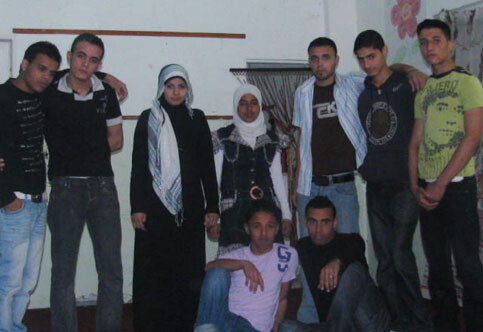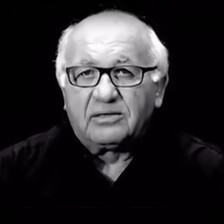Nuseirat refugee camp, Gaza Strip 30 March 2010

Mayada al-Hallaj with her team of mimers in Gaza. (Rami Almeghari)
In the Nuseirat refugee camp in the central Gaza Strip, an ordinary family has raised a talented daughter. Her talent is not something widespread in Gaza or even elsewhere in the world. Mayada al-Hallaj, 25, currently studying sociology at university, has also been a mime artist and teacher for the last few years.
“Right after I finished high school, I began to have a great interest in mime so I started to watch TV and surf the Internet for mime shows,” al-Hallaj explained as she prepared to begin a show at the al-Karmel Association, a nongovernmental organization that promotes Palestinian folkloric culture, in Nusierat camp. “At the beginning I found myself doing some movements that expressed what I felt inside, when I realized that this what was called mime.”
Nine youths with painted faces aged 15 to 21 prepared to perform the show, called Good and Evil, with al-Hallaj, while Egyptian symphony music played in the background.
Wearing a traditional face-covering known as a niqab, al-Hallaj leads the seven-minute-long show, steering the movements of her team. “I wear the niqab because in the mime tradition, the performer wears a mask,” al-Hallaj had explained. The niqab, she added, “represents for me the conservative community of the refugee camp. However, I am pleased that we can do our performances without impediments.”
Noura Abu Ayyash, 15, plays a character called “the butterfly” who sweeps around the stage between those representing good, and those representing evil — all of whom are finally united at the end of the piece.
“As you noticed through this performance,” al-Hallaj explained, “we wanted to send out a message of peace, harmony and reconciliation among the community. Evil and good always encounter eachother, but evil cannot truimph over good. We hope that Palestinians will be united.”
Abu Ayyash says she was originally interested in ballet but learned about al-Hallaj’s mime work and decided to join. “Through performing, I feel that I can express my inner feelings,” Abu Ayyash said, “I do look forward to this art becoming more widespread in the country.”
Muhammad al-Najjar, another member of the troupe, said he discovered mime when he started dancing at home: “I found these movements as a sort of relief for many things inside me. I found them expressing myself. Then I got to know Mayada through the al-Karmel Association.”
Mayada Al-Hallaj says she has performed three major shows in Gaza at the invitation of local organizations. The shows, she said, were designed to reflect on current social problems.
Her troupe faces challenges however, including a lack of costumes as well as space to practice. Because of the Israeli blockade, there are no opportunities for team members to travel or train abroad. Al-Hallaj explains she has never had any training, but learned mime only by reading about it and through practice.
Ayman al-Hour, director general of the al-Karmel Association in Nusierat, agreed that there is a lack of cultural activities in Gaza due to the Israeli siege as well as the division between the West Bank and Gaza Strip.
“Young people have lots of energy that needs to be released in a better way,” said al-Hour. “They need those who can back them the way we are doing at this association, within our own capabilities. However, the cultural scene in Gaza needs more work in order to improve it.”
At her family home in the Nuseirat refugee camp, Mayada al-Hallaj’s father Hammad and mother Umm Ahmad expressed their satisfaction with their daughter’s unorthodox art.
“I have always given my children the freedom to choose whatever they like without interference from my part,” said Hammad al-Hallaj, “Yet their choices should respect the social and religious traditions of our Palestinian community. I have found that my daughter has a great interest in this art, so I have allowed her to continue. I do believe that this art does not contradict our traditions and habits in the community.”
Umm Ahmad also expressed encouragement for her daughter. “In the beginning, when I first saw Mayada performing, I was surprised. I had not known this art before, yet after I attended one of her performances somewhere in Gaza, I really liked what she does,” Umm Ahmad said with a smile.
“I do hope that I become a star in the world of mime in Gaza. I look forward to spreading this art as widely as I can. This is a fine art that releases lots of energy and reflects the society in a unique way,” Mayada al-Hallaj said after wrapping up the show.
Rami Almeghari is a journalist and university lecturer based in the Gaza Strip.





